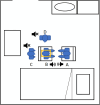Effectiveness and reliability of hypnosis in stereotaxy: a randomized study
- PMID: 38411747
- PMCID: PMC10899299
- DOI: 10.1007/s00701-024-05943-0
Effectiveness and reliability of hypnosis in stereotaxy: a randomized study
Abstract
Background: Patients suffering from Parkinson's disease (PD) may experience pain during stereotactic frame (SF) fixation in deep brain stimulation (DBS). We assessed the role of hypnosis during the SF fixation in PD patients undergoing awake bilateral subthalamic nucleus (STN) DBS.
Methods: N = 19 patients were included (N = 13 males, mean age 63 years; N = 10 allocated to the hypnosis and N = 9 allocated to the control groups). Patients were randomly assigned to the interventional (hypnosis and local anesthesia) or non-interventional (local anesthesia only) groups. The primary outcome was the pain perceived (the visual analogue scale (VAS)). Secondary outcomes were stress, anxiety, and depression, as measured by the perceived stress scale (PSS) and hospital anxiety and depression scale (HADS). Procedural distress was measured using the peritraumatic distress inventory (PDI-13).
Results: In the hypnosis group, VASmean was 5.6 ± 2.1, versus 6.4 ± 1.2 in the control group (p = 0.31). Intervention and control groups reported similar VASmax scores (7.6 ± 2.1 versus 8.6 ± 1.6 (p = 0.28), respectively). Both groups had similar HADS scores (6.2 ± 4.3 versus 6.7 ± 1.92, p = 0.72 (HADSa) and 6.7 ± 4.2 versus 7.7 ± 3, p = 0.58 (HADSd)), so were the PSS scores (26.1 ± 6.3 versus 25.1 ± 7, p = 0.75). Evolutions of VASmean (R2 = 0.93, 95% CI [0.2245, 1.825], p = 0.03) and PDI-13 scores (R2 = 0.94, 95% CI [1.006, 6.279], p = 0.02) significantly differ over follow-up with patients in the hypnosis groups showing lower scores.
Conclusion: In this unblinded, randomized study, hypnosis does not influence pain, anxiety, and distress during awake SF fixation but modulates pain memory over time and may prevent the integration of awake painful procedures as a bad experience into the autobiographical memory of patients suffering from PD. A randomized controlled study with more data is necessary to confirm our findings.
Trial registration: ClinicalTrials.gov NCT03074422.
Keywords: Deep brain stimulation; Hypnosis; Pain; Parkinson’s disease.
© 2024. The Author(s).
Conflict of interest statement
The authors declare no competing interests.
Figures





Similar articles
-
Clinical outcomes following awake and asleep deep brain stimulation for Parkinson disease.J Neurosurg. 2018 Mar 16;130(1):109-120. doi: 10.3171/2017.8.JNS17883. Epub 2018 Mar 16. J Neurosurg. 2018. PMID: 29547091
-
Acute response of non-motor symptoms to subthalamic deep brain stimulation in Parkinson's disease.Parkinsonism Relat Disord. 2017 Aug;41:113-117. doi: 10.1016/j.parkreldis.2017.05.003. Epub 2017 May 8. Parkinsonism Relat Disord. 2017. PMID: 28528805
-
Subthalamic Stimulation Improves Quality of Sleep in Parkinson Disease: A 36-Month Controlled Study.J Parkinsons Dis. 2021;11(1):323-335. doi: 10.3233/JPD-202278. J Parkinsons Dis. 2021. PMID: 33074192 Clinical Trial.
-
Psychological interventions for needle-related procedural pain and distress in children and adolescents.Cochrane Database Syst Rev. 2018 Oct 4;10(10):CD005179. doi: 10.1002/14651858.CD005179.pub4. Cochrane Database Syst Rev. 2018. PMID: 30284240 Free PMC article.
-
Deep brain stimulation for Parkinson's disease: meta-analysis of results of randomized trials at varying lengths of follow-up.J Neurosurg. 2018 Apr;128(4):1199-1213. doi: 10.3171/2016.11.JNS16715. Epub 2017 Jun 30. J Neurosurg. 2018. PMID: 28665252
References
-
- Adachi T, Fujino H, Nakae A, Mashimo T, Sasaki J (2014) A meta-analysis of hypnosis for chronic pain problems: a comparison between hypnosis, standard care, and other psychological interventions. Int J Clin Exp Hypn 62:1–28. 10.1080/00207144.2013.841471 - PubMed
-
- Agard E, Pernod C, El Chehab H, Russo A, Haxaire M, Dot C (2016) A role for hypnosis in cataract surgery: report of 171 procedures. J Fr Ophtalmol 39:287–291. 10.1016/j.jfo.2015.04.024 - PubMed
-
- Bellinghausen L, Collange J, Botella M, Emery JL, Albert E (2009) Factorial validation of the French scale for perceived stress in the workplace. Sante Publique 21:365–373 - PubMed
-
- Bhuvaneswar C, Spiegel D (2013) An eye for an I: a 35-year-old woman with fluctuating oculomotor deficits and dissociative identity disorder. Int J Clin Exp Hypn 61:351–370. 10.1080/00207144.2013.784115 - PubMed
Publication types
MeSH terms
Supplementary concepts
Associated data
LinkOut - more resources
Full Text Sources
Medical
Research Materials

